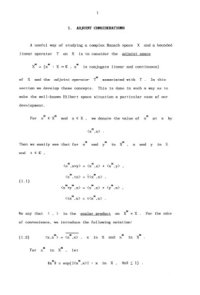
Ebook: Spectral perturbation and approximation with numerical experiments
Author: Balmohan Vishnu Limaye
- Genre: Mathematics // Functional Analysis
- Series: Proceedings of the Centre for Mathematical Analysis Australian National University 13
- Year: 1987
- Publisher: Centre for Mathematical Analysis
- City: Canberra
- Edition: 1
- Language: English
- djvu
This monograph has grown out of a course which I have been giving at the Indian Institute of Technology Bombay (India) since 1981. A rough draft of the monograph was written while I was visiting Institute IMAG, Grenoble (France in 1984-1985. It was revised and finalized during my visits to the Centre for Mathematical Analysis at the Australian National University, Canberra (Australia) in 1986 and 1987.
The purpose of this project is to introduce the reader who has already taken a course in Functional Analysis to the beautiful as well as useful area of spectral approximation. Instead of aiming at full generality, I have tried to deal with simpler situations in order to highlight the main ideas. Thus, only bounded linear operators on a Banach space are considered here, although much of the theory and practice can be extended to densely defined closed operators.
Similarly, special cases of important results are treated in the text, and their generalizations are indicated in the problems that follow. Being an introductory text, the scope of this monograph is much more limited than the books of Anselone [AN], Bäumgartel [BA], Chatelin [C], Golub-Van Loan [GV] and Kato [K]. While I have relied heavily on these treatises for classical as well as modern development of various topics, parts of this book arose from my collaboration with my former students Lalita Deshpande, Rekha Kulkarni and Thamban Nair. The numerical experiments given at the end of the book were performed in collaboration with Rekha Kulkarni.
The first chapter recalls preliminary results from functional analysis that will be needed in the sequel. The second chapter gives a systematic development of the spectral theory with particular emphasis on the spectral decomposition theorem and the discrete part of the spectrum of a bounded operator. The third chapter deals with the change in the spectrum of an operator due to a perturbation of the operator, and develops various iteration schemes for obtaining a simple eigenvalue and a corresponding eigenvector of the perturbed operator. Some iterative methods for the finite dimensional eigenvalue problems are also reviewed. The fourth chapter discusses some ways of approximating an operator by a sequence of ‘known’ operators while keeping an eye on spectral properties. In this chapter, the treatment of norm and collectively compact approximations is unified with the help of ‘resolvent operator approximation’. The fifth chapter brings into practice the theory developed earlier by presenting algorithms which are suitable for numerical work on a computer. Several numerical results and typical computer programs are given in this chapter. Each chapter has four sections. The problems at the end of each section form an integral part of this book. Two appendices supplement the results in Sections 7, 12 and 19. The index at the end may prove to be useful, particularly since the definitions are not numbered. New terms are underlined in their definitions, while italics are used for emphasis.
The purpose of this project is to introduce the reader who has already taken a course in Functional Analysis to the beautiful as well as useful area of spectral approximation. Instead of aiming at full generality, I have tried to deal with simpler situations in order to highlight the main ideas. Thus, only bounded linear operators on a Banach space are considered here, although much of the theory and practice can be extended to densely defined closed operators.
Similarly, special cases of important results are treated in the text, and their generalizations are indicated in the problems that follow. Being an introductory text, the scope of this monograph is much more limited than the books of Anselone [AN], Bäumgartel [BA], Chatelin [C], Golub-Van Loan [GV] and Kato [K]. While I have relied heavily on these treatises for classical as well as modern development of various topics, parts of this book arose from my collaboration with my former students Lalita Deshpande, Rekha Kulkarni and Thamban Nair. The numerical experiments given at the end of the book were performed in collaboration with Rekha Kulkarni.
The first chapter recalls preliminary results from functional analysis that will be needed in the sequel. The second chapter gives a systematic development of the spectral theory with particular emphasis on the spectral decomposition theorem and the discrete part of the spectrum of a bounded operator. The third chapter deals with the change in the spectrum of an operator due to a perturbation of the operator, and develops various iteration schemes for obtaining a simple eigenvalue and a corresponding eigenvector of the perturbed operator. Some iterative methods for the finite dimensional eigenvalue problems are also reviewed. The fourth chapter discusses some ways of approximating an operator by a sequence of ‘known’ operators while keeping an eye on spectral properties. In this chapter, the treatment of norm and collectively compact approximations is unified with the help of ‘resolvent operator approximation’. The fifth chapter brings into practice the theory developed earlier by presenting algorithms which are suitable for numerical work on a computer. Several numerical results and typical computer programs are given in this chapter. Each chapter has four sections. The problems at the end of each section form an integral part of this book. Two appendices supplement the results in Sections 7, 12 and 19. The index at the end may prove to be useful, particularly since the definitions are not numbered. New terms are underlined in their definitions, while italics are used for emphasis.
Download the book Spectral perturbation and approximation with numerical experiments for free or read online
Continue reading on any device:

Last viewed books
Related books
{related-news}
Comments (0)